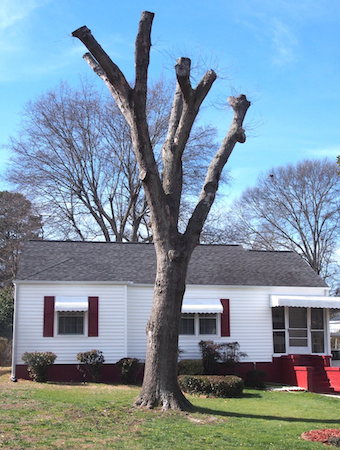Maybe, or maybe not. The answer depends on your reason for pruning.
Four Good Reasons to Prune a Tree
To remove dead wood
Dead branches of size should be pruned out to promote health and eliminate danger from falling branches. Pruning dead twigs on small trees, such as Japanese maples, provides a better appearance; however, twig pruning is impractical for large trees if your budget is limited. All trees naturally cast off dead twigs.
Safety
Branches with a weak attachment to the trunk and other defects are pruned out to promote safety and long-range growth. This is called structural pruning. Only use highly-trained companies to do this kind of work. Your tree could get destroyed by overpruning (“topping,” see below).
“Crown reduction”
Sometimes the height or branch spread of a tree needs to be reduced in order to enhance its potential for growth over the long term. Here too, use a company with highly-trained trimmers. This kind of work should be done in stages, not all at once. If a complete reduction is done all at once, a tree can go into shock and die.
“Elevation”
Low branches that are getting too close to structures or walkways should be pruned. The normal clearance needed is 10 feet above the roof or walkway. Pruning any higher than 10 feet is a waste of money and could damage the tree’s health.
Three Bad Reasons to Prune a Tree
Interior thinning
This is where the small branches and twigs “inside” the tree are cut off to enhance the appearance of the tree’s structure or to decrease wind resistance (its risk of being blown over by heavy wind). This reasoning has been proven incorrect. Scientists now tell us that thick interior growth is better for the tree so that wind passes around it rather than through it.
Pruning for more sunlight for the garden or yard
People are often unaware that large trees are incompatible with large gardens and lush lawns. Why? If you prune large branches to get a few extra minutes of sunlight exposure, you can harm the tree! In addition, the large pruning wounds left after a pruning job can create problems down the road by providing entry points for decay and fungus when the tree can’t close over the wound fast enough. By over-pruning a tree to get the desired results, the tree often ends up looking butchered.
“Topping”
“Topping” a tree means exactly what it says: cutting off most of the top of a tree. If a tree service recommends this, their reason to you is usually that it will "make the tree less prone to falling over." But topping is the worst thing you can do to a tree. It deprives the tree of the green leaves it needs to gather sunlight and make food, and usually results in the tree's death.
The only exception to this rule is a Bradford pear. These very fast-growing and brittle trees grow to a large size quickly and then fall apart. They can withstand severe pruning. This species is one of the few which is not subject to the City of Atlanta Tree Protection Ordinance.
Proper pruning techniques, please!
Whenever you have your trees pruned, make sure that the tree service you hire follows established industry guidelines for tree trimming:
- Appropriate pruning does not leave ugly stubs in the tree.
- Don’t over-prune! Current general recommendations are to remove no more than 15% of the tree’s leaves in one year.
- Cut only dead wood or branches that are close to the roof. A clearance of 10 feet is sufficient.
- The person who prunes the tree should never climb it with leg spikes.
